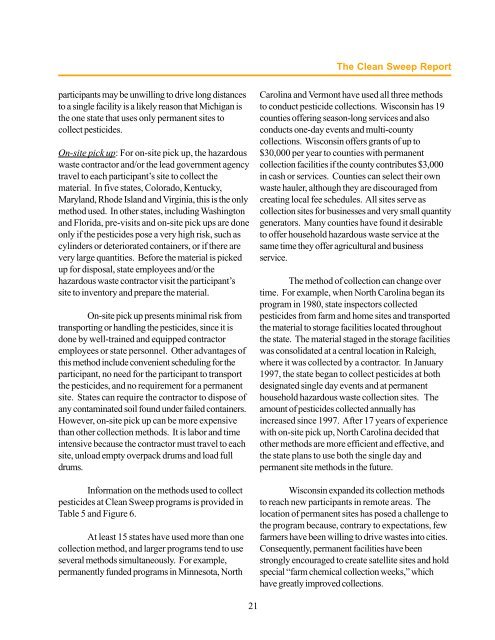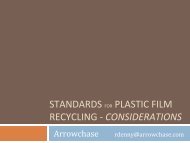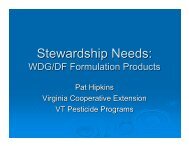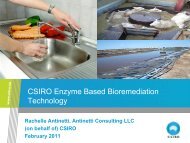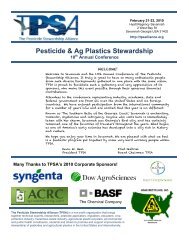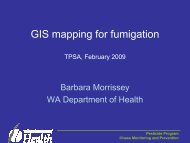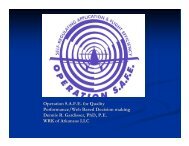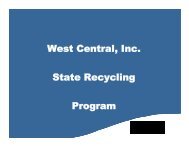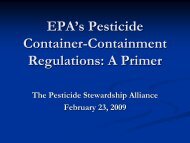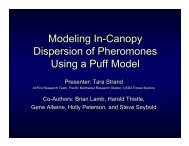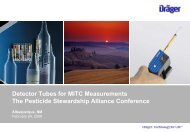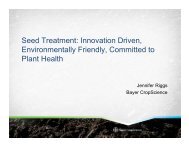Clean Sweep Programs - US Environmental Protection Agency
Clean Sweep Programs - US Environmental Protection Agency
Clean Sweep Programs - US Environmental Protection Agency
- No tags were found...
You also want an ePaper? Increase the reach of your titles
YUMPU automatically turns print PDFs into web optimized ePapers that Google loves.
The <strong>Clean</strong> <strong>Sweep</strong> Reportparticipants may be unwilling to drive long distancesto a single facility is a likely reason that Michigan isthe one state that uses only permanent sites tocollect pesticides.On-site pick up: For on-site pick up, the hazardouswaste contractor and/or the lead government agencytravel to each participant’s site to collect thematerial. In five states, Colorado, Kentucky,Maryland, Rhode Island and Virginia, this is the onlymethod used. In other states, including Washingtonand Florida, pre-visits and on-site pick ups are doneonly if the pesticides pose a very high risk, such ascylinders or deteriorated containers, or if there arevery large quantities. Before the material is pickedup for disposal, state employees and/or thehazardous waste contractor visit the participant’ssite to inventory and prepare the material.On-site pick up presents minimal risk fromtransporting or handling the pesticides, since it isdone by well-trained and equipped contractoremployees or state personnel. Other advantages ofthis method include convenient scheduling for theparticipant, no need for the participant to transportthe pesticides, and no requirement for a permanentsite. States can require the contractor to dispose ofany contaminated soil found under failed containers.However, on-site pick up can be more expensivethan other collection methods. It is labor and timeintensive because the contractor must travel to eachsite, unload empty overpack drums and load fulldrums.Information on the methods used to collectpesticides at <strong>Clean</strong> <strong>Sweep</strong> programs is provided inTable 5 and Figure 6.At least 15 states have used more than onecollection method, and larger programs tend to useseveral methods simultaneously. For example,permanently funded programs in Minnesota, NorthCarolina and Vermont have used all three methodsto conduct pesticide collections. Wisconsin has 19counties offering season-long services and alsoconducts one-day events and multi-countycollections. Wisconsin offers grants of up to$30,000 per year to counties with permanentcollection facilities if the county contributes $3,000in cash or services. Counties can select their ownwaste hauler, although they are discouraged fromcreating local fee schedules. All sites serve ascollection sites for businesses and very small quantitygenerators. Many counties have found it desirableto offer household hazardous waste service at thesame time they offer agricultural and businessservice.The method of collection can change overtime. For example, when North Carolina began itsprogram in 1980, state inspectors collectedpesticides from farm and home sites and transportedthe material to storage facilities located throughoutthe state. The material staged in the storage facilitieswas consolidated at a central location in Raleigh,where it was collected by a contractor. In January1997, the state began to collect pesticides at bothdesignated single day events and at permanenthousehold hazardous waste collection sites. Theamount of pesticides collected annually hasincreased since 1997. After 17 years of experiencewith on-site pick up, North Carolina decided thatother methods are more efficient and effective, andthe state plans to use both the single day andpermanent site methods in the future.Wisconsin expanded its collection methodsto reach new participants in remote areas. Thelocation of permanent sites has posed a challenge tothe program because, contrary to expectations, fewfarmers have been willing to drive wastes into cities.Consequently, permanent facilities have beenstrongly encouraged to create satellite sites and holdspecial “farm chemical collection weeks,” whichhave greatly improved collections.21


